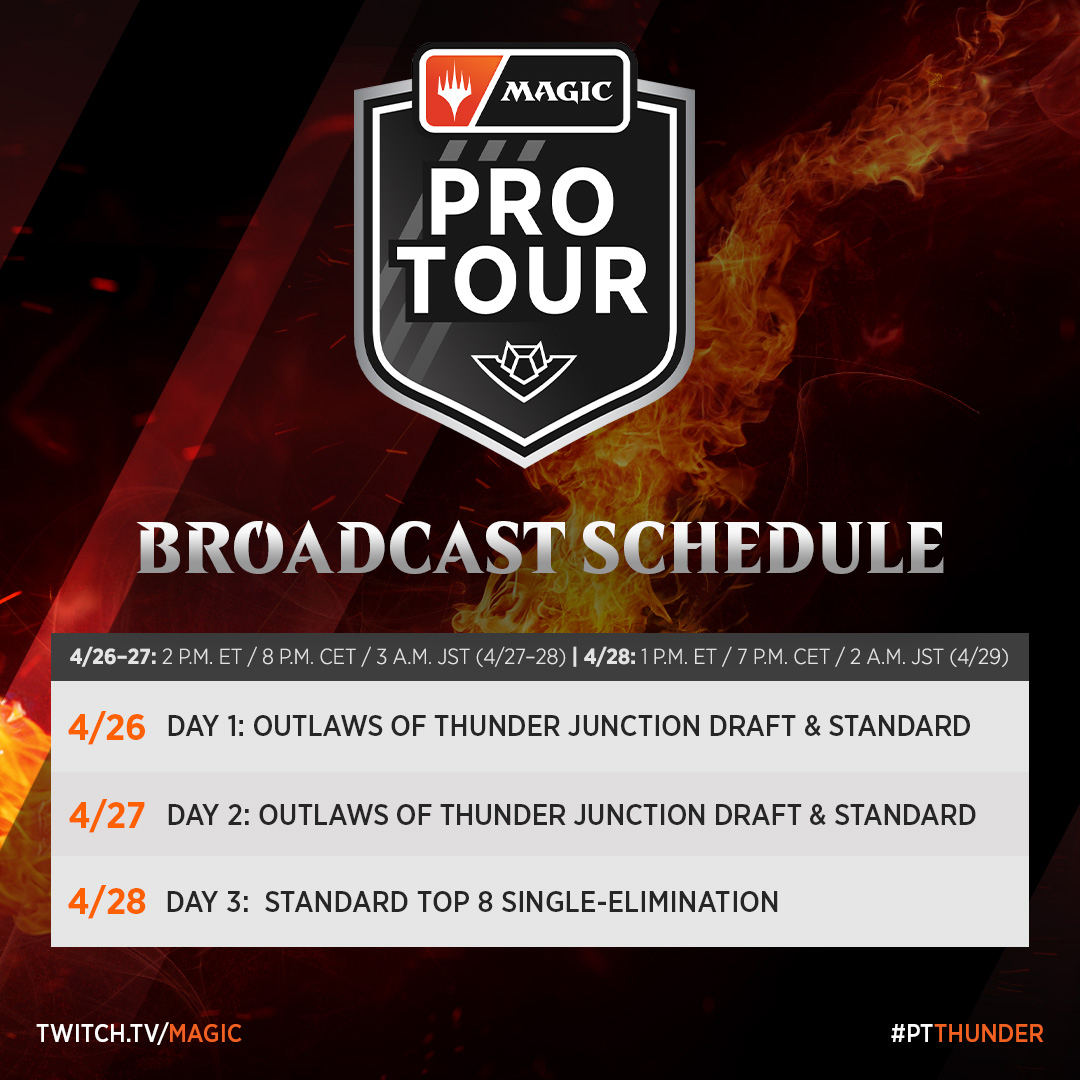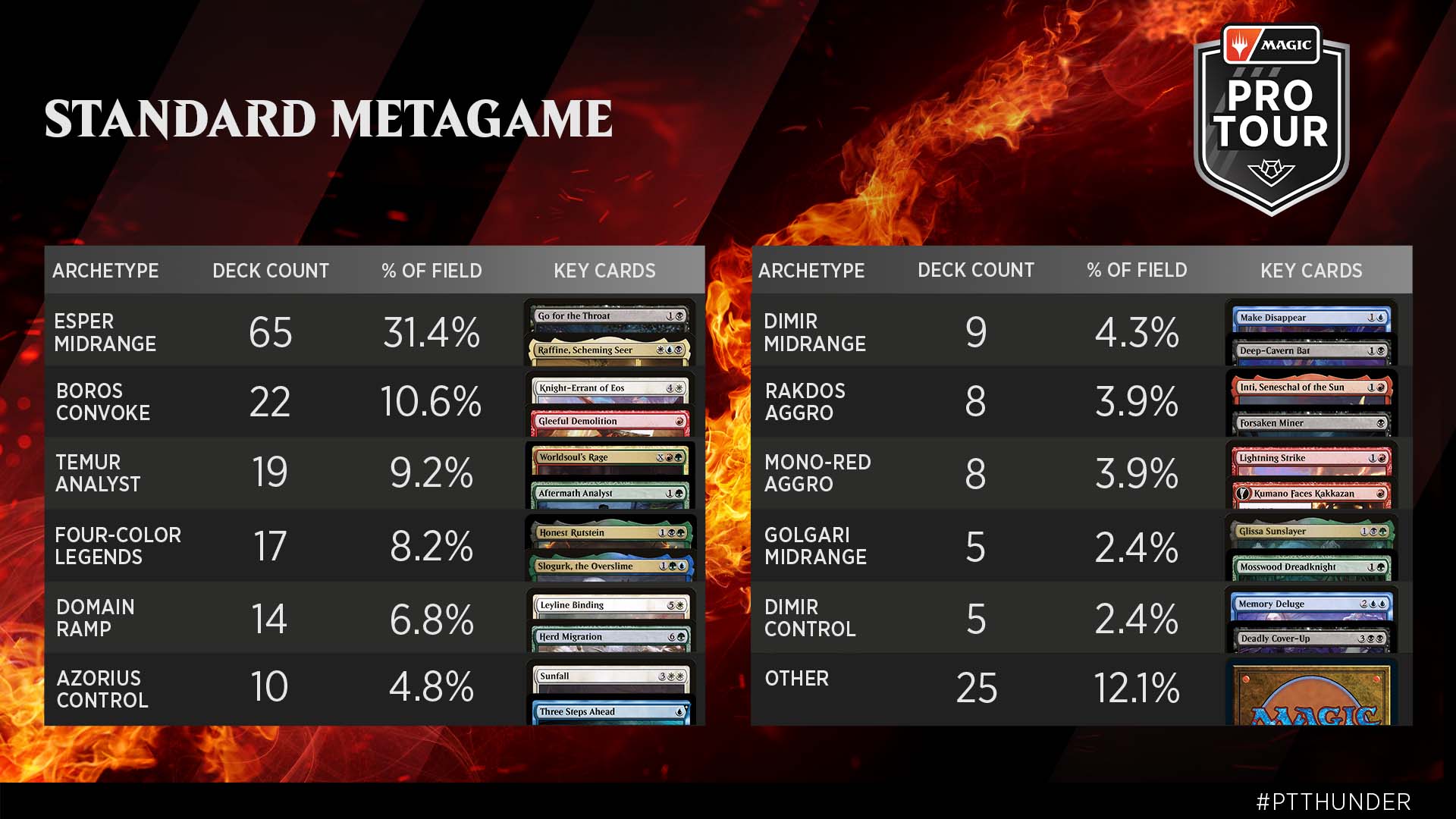The decklists are in, the data is ready, and the second Pro Tour of 2024 begins tomorrow! At Pro Tour Thunder Junction, taking place April 26–28 in Seattle, 207 of the world’s best Magic: The Gathering players will compete for $500,000 in prizes, several Magic World Championship invites, and a prestigious trophy. Standard now features more than 3,300 legal cards, so the competitors had to tackle the challenge of navigating some of the highest power levels we’ve ever seen in this format.
The field includes top players from Regional Championships, online qualifiers, and preceding Pro Tours, as well as Magic Hall of Famers and reigning World Champion Jean-Emmanuel Depraz. The formats are Outlaws of Thunder Junction Booster Draft in the morning of Friday and Saturday, followed by Standard for five rounds afterward each of those days. Standard is also the Top 8 format on Sunday.
To follow all the action, catch the stream at twitch.tv/magic, which begins at 11 a.m. Pacific Time on Friday and Saturday and at 10 a.m. Pacific Time on Sunday. Take a look at the viewer’s guide for more information.
Standard is a 60-card format that rotates every fall. Currently, it allows expansion sets from Innistrad: Midnight Hunt forward. Standard is often dominated by midrange decks, and it’s no different this time around. Yet the newly added cards from Outlaws of Thunder Junction have shaken things up. The metagame at the Pro Tour breaks down as follows.
| Deck Archetype | Number of Players | Percentage of Field |
|---|---|---|
| 1. Esper Midrange | 65 | 31.4% |
| 2. Boros Convoke | 22 | 10.6% |
| 3. Temur Analyst | 19 | 9.2% |
| 4. Four-Color Legends | 17 | 8.2% |
| 5. Domain Ramp | 14 | 6.8% |
| 6. Azorius Control | 10 | 4.8% |
| 7. Dimir Midrange | 9 | 4.3% |
| 8. Rakdos Aggro | 8 | 3.9% |
| 9. Mono-Red Aggro | 8 | 3.9% |
| 10. Golgari Midrange | 5 | 2.4% |
| 11. Dimir Control | 5 | 2.4% |
| 12. Jund Analyst | 2 | 1.0% |
| 13. Gruul Aggro | 2 | 1.0% |
| 14. Orzhov Bronco | 2 | 1.0% |
| 15. Temur Prowess | 2 | 1.0% |
| 16. Azorius Artifacts | 2 | 1.0% |
| 17. Domain Control | 1 | 0.5% |
| 18. Bant Control | 1 | 0.5% |
| 19. Mono-Blue Cauldron | 1 | 0.5% |
| 20. Boros Prowess | 1 | 0.5% |
| 21. Sultai Midrange | 1 | 0.5% |
| 22. Temur Calamity | 1 | 0.5% |
| 23. Esper Reanimator | 1 | 0.5% |
| 24. Mono-Black Bloodletter | 1 | 0.5% |
| 25. Jeskai Artifacts | 1 | 0.5% |
| 26. Sultai Legends | 1 | 0.5% |
| 27. Dimir Reanimator | 1 | 0.5% |
| 28. Five-Color Legends | 1 | 0.5% |
| 29. Grixis Reanimator | 1 | 0.5% |
| 30. Rakdos Midrange | 1 | 0.5% |
| 31. Five-Color Analyst | 1 | 0.5% |
The metagame features a lot of Esper Midrange, but it looks quite diverse beyond that. There are dozens of different archetypes, including aggro, midrange, control, ramp, combo, and plenty of spice. All Standard Constructed decklists for the tournament will be published on the Pro Tour Thunder Junction event page on Friday April 26 at the beginning of Round 4 gameplay, approximately at 2 p.m. PT.
612498
574569
Deep-Cavern Bat
The most-played nonland cards across all main decks and sideboards were
Although the metagame bears many similarities to the one right before the release of Outlaws of Thunder Junction, which I covered in last week’s Standard primer, the introduction of hundreds of new cards has shaken things up. Let’s take a closer look at four of the most important takeaways, developments, and surprises from Pro Tour Thunder Junction.
The Dominance of Esper Midrange
555414
660318
Over the past few months, black midrange strategies had typically formed 30–40% of the Standard metagame, but it was never clear what the best color combination was. Dimir Midrange was the most prominent right before the release of Outlaws of Thunder Junction, leveraging its smooth mana base, low curve, and efficient countermagic, but the new set has changed things. After the introduction of Outlaws of Thunder Junction, Esper Midrange decisively took back the crown.
With
The Resurgence of Four-Color Legends
Relic of Legends
655148
Over the past few months, Four-Color Legends had been a fringe player in Standard, typically claiming 1–2% of the metagame. Combining elements of midrange, combo, and ramp, the deck excelled at fueling mana from
Outlaws of Thunder Junction offered a substantial boost to the deck in the form of
The Disappearance of Bant Toxic
602722
602564
While most of the attention will go to the decks on top of the metagame, it’s also important to recognize what is not there: Bant Toxic. Over the past months, the archetype had fluctuated around 4-8% of the metagame, preying on the slow nature of Domain Ramp while sidestepping the life gain lands from Temur Analyst with its poison counters. At the Pro Tour, however, zero players registered
The deck did not gain anything of note from the latest set, while its favorable matchups had dwindled and sweeper effects were ticking up. As a result, no one will be poisoned out of the game at Pro Tour Thunder Junction, barring a stray
A Plethora of Novel Strategies
636796
655023
Between the main Outlaws of Thunder Junction (OTJ) set and The Big Score (BIG) bonus sheet, the latest set was one of the biggest Standard releases ever, introducing an abundance of new build-arounds. I will highlight the most exciting options in tommorow’s article on the spiciest decklist from the Pro Tour, but one thing is for sure: the Standard rounds on the West Coast are going to be wild.
Some players may use
Despite the high bar set by the existing Standard card pool, Outlaws of Thunder Junction had a considerable impact on the format. The following table breaks down all new-to-Standard cards among Pro Tour decklists. There’s a lot.
| Card Name | Total Number of Copies | Main Deck | Sideboard |
|---|---|---|---|
| Concealed Courtyard | 197 | 197 | 0 |
| Pest Control | 163 | 6 | 157 |
| Rest in Peace | 154 | 0 | 154 |
| Duelist of the Mind | 97 | 97 | 0 |
| Inspiring Vantage | 94 | 94 | 0 |
| Three Steps Ahead | 61 | 60 | 1 |
| Honest Rutstein | 56 | 56 | 0 |
| Slickshot Show-Off | 45 | 45 | 0 |
| Blooming Marsh | 44 | 44 | 0 |
| Bonny Pall, Clearcutter | 35 | 1 | 34 |
| Forsaken Miner | 32 | 32 | 0 |
| Tinybones, the Pickpocket | 32 | 32 | 0 |
| Caustic Bronco | 28 | 28 | 0 |
| Shoot the Sheriff | 27 | 27 | 0 |
| Nurturing Pixie | 25 | 25 | 0 |
| Demonic Ruckus | 19 | 19 | 0 |
| Hostile Investigator | 19 | 8 | 11 |
| Dust Animus | 16 | 4 | 12 |
| Harvester of Misery | 16 | 7 | 9 |
| Pillage the Bog | 15 | 15 | 0 |
| Scorching Shot | 15 | 11 | 4 |
| Make Your Own Luck | 14 | 14 | 0 |
| Spirebluff Canal | 14 | 14 | 0 |
| Vial Smasher, Gleeful Grenadier | 13 | 13 | 0 |
| Assimilation Aegis | 12 | 9 | 3 |
| Simulacrum Synthesizer | 12 | 12 | 0 |
| Botanical Sanctum | 11 | 11 | 0 |
| Insatiable Avarice | 11 | 10 | 1 |
| Aven Interrupter | 10 | 0 | 10 |
| Torpor Orb | 9 | 0 | 9 |
| Pitiless Carnage | 8 | 8 | 0 |
| Ancient Cornucopia | 8 | 8 | 0 |
| Kaervek, the Punisher | 8 | 7 | 1 |
| Phantom Interference | 7 | 7 | 0 |
| Tinybones Joins Up | 7 | 7 | 0 |
| Snakeskin Veil | 6 | 6 | 0 |
| Gisa, the Hellraiser | 6 | 5 | 1 |
| Rush of Dread | 6 | 3 | 3 |
| Fomori Vault | 5 | 5 | 0 |
| Bristly Bill, Spine Sower | 4 | 0 | 4 |
| Harrier Strix | 4 | 4 | 0 |
| Dance of the Tumbleweeds | 4 | 4 | 0 |
| Legion Extruder | 3 | 3 | 0 |
| Final Showdown | 3 | 3 | 0 |
| Roxanne, Starfall Savant | 3 | 0 | 3 |
| Kellan, the Kid | 3 | 3 | 0 |
| Vadmir, New Blood | 3 | 3 | 0 |
| Requisition Raid | 3 | 0 | 3 |
| Lively Dirge | 3 | 3 | 0 |
| Return the Favor | 2 | 0 | 2 |
| Stoic Sphinx | 2 | 0 | 2 |
| Binding Negotiation | 2 | 0 | 2 |
| Goldvein Hydra | 1 | 1 | 0 |
| The Gitrog, Ravenous Ride | 1 | 0 | 1 |
| Neutralize the Guards | 1 | 0 | 1 |
| Annie Flash, the Veteran | 1 | 0 | 1 |
| Arid Archway | 1 | 1 | 0 |
| Annie Joins Up | 1 | 1 | 0 |
| Bandit’s Haul | 1 | 1 | 0 |
The most-played new cards are
657178
Nurturing Pixie
The enemy-color fast lands make a huge difference for the early-game mana consistency of aggro decks. Previously, it could be difficult for Boros Convoke to cast
655016
655137
Blue players gained several new tools as well. For control players,
655087
Demonic Ruckus
For red aggro players,
Shoot the Sheriff
Forsaken Miner
Black decks also gained several new tools.
At Pro Tour Thunder Junction, all competitors who clinch 36 match points and/or reach the Top 8 will receive an invitation to Magic World Championship 30—the crown jewel of organized play in 2024. As we count down the weeks leading up to that tournament in late October, each week I’m taking a look at a great deck from a past Magic World Championship. After reviewing the World Championships from 1994, 1995, 1996, 1997, and 1998 in preceding weeks, let’s go back in time to 1999.
At the 1999 Magic World Championship, which took place in Tokyo on August 26–28 of that year, 208 players from 32 countries competed across Rochester Draft, Standard, and Extended. In the Standard Top 8 playoffs on Sunday, Kai Budde from Germany emerged victorious in what would be the first of his seven career Pro Tour victories.
In the finals, Budde defeated Mark Le Pine 3-0 in about 20 minutes, the fastest World Championship finals in history. “The games in the finals were not close,” Budde recalled. “I just had

